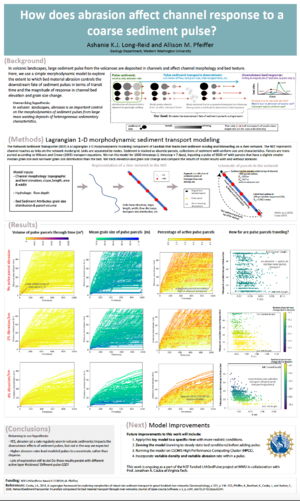2023 CSDMS meeting-098: Difference between revisions
From CSDMS
No edit summary |
No edit summary |
||
| Line 40: | Line 40: | ||
{{CSDMS meeting abstract template 2023 | {{CSDMS meeting abstract template 2023 | ||
|CSDMS meeting abstract=In gravel-bedded rivers, bed material abrasion is a well-recognized control on the balance between fine and coarse sediment fluxes. We suggest that in some landscapes, abrasion may also be an important control on the morphodynamics of sediment pulses. Here, we employ a simple morphodynamic model to explore the extent to which bed material abrasion controls the downstream fate of sediment pulses in terms of transit time and the magnitude of response in channel bed elevation and grain size change. The Network Sediment Transporter (NST) is a Lagrangian 1-D morphodynamic model component that tracks bed sediment moving and interacting on a river network. The NST is implemented in Landlab, a Python-based package for modeling the Earth’s surface. The NST tracks ‘parcels’ of sediment (collections of grains of homogeneous size, density, etc.) as they transport through the network, allowing us to explicitly tag and follow sediment as originating in the mass wasting deposit and give that sediment unique abrasion characteristics. The model requires inputs about channel morphology, flow, and bed sediment attributes. Here, we compare the results of a simple sediment pulse simulation without abrasion of the bed material to an identical pulse with abrasion rates equal to measurements made on a volcanic mass wasting deposit in the Cascade Range of Washington. The differences between pulse behavior with and without abrasion have implications for hazards in volcanic terrains where channels are commonly subject to large mass wasting deposits of heterogeneous sedimentary characteristics. Understanding the fate of these large sediment pulses will increase our understanding of downstream channel aggradation and increases in flood frequency. | |CSDMS meeting abstract=In gravel-bedded rivers, bed material abrasion is a well-recognized control on the balance between fine and coarse sediment fluxes. We suggest that in some landscapes, abrasion may also be an important control on the morphodynamics of sediment pulses. Here, we employ a simple morphodynamic model to explore the extent to which bed material abrasion controls the downstream fate of sediment pulses in terms of transit time and the magnitude of response in channel bed elevation and grain size change. The Network Sediment Transporter (NST) is a Lagrangian 1-D morphodynamic model component that tracks bed sediment moving and interacting on a river network. The NST is implemented in Landlab, a Python-based package for modeling the Earth’s surface. The NST tracks ‘parcels’ of sediment (collections of grains of homogeneous size, density, etc.) as they transport through the network, allowing us to explicitly tag and follow sediment as originating in the mass wasting deposit and give that sediment unique abrasion characteristics. The model requires inputs about channel morphology, flow, and bed sediment attributes. Here, we compare the results of a simple sediment pulse simulation without abrasion of the bed material to an identical pulse with abrasion rates equal to measurements made on a volcanic mass wasting deposit in the Cascade Range of Washington. The differences between pulse behavior with and without abrasion have implications for hazards in volcanic terrains where channels are commonly subject to large mass wasting deposits of heterogeneous sedimentary characteristics. Understanding the fate of these large sediment pulses will increase our understanding of downstream channel aggradation and increases in flood frequency. | ||
|CSDMS meeting posterPDF= CSDMS_poster_2023_Simulated_sediment_transport.pdf | |||
|CSDMS meeting posterPNG= CSDMS_poster_2023_Simulated_sediment_transport.png | |||
|CSDMS meeting | |||
}} | }} | ||
{{blank line template}} | {{blank line template}} | ||
Latest revision as of 16:29, 25 May 2023
(if you haven't already)
Log in (or create account for non-CSDMS members)
Forgot username? Search or email:CSDMSweb@colorado.edu
Browse abstracts
Simulated river channel response to a coarse sediment pulse with and without bed material abrasion
Ashanie K.J. Long-Reid,
(she/her),Western Washington University Bellingham Washington, United States. longrea@wwu.edu
Allison M. Pfeiffer, Western Washington University Bellingham Washington, United States. pfeiffa@wwu.edu
In gravel-bedded rivers, bed material abrasion is a well-recognized control on the balance between fine and coarse sediment fluxes. We suggest that in some landscapes, abrasion may also be an important control on the morphodynamics of sediment pulses. Here, we employ a simple morphodynamic model to explore the extent to which bed material abrasion controls the downstream fate of sediment pulses in terms of transit time and the magnitude of response in channel bed elevation and grain size change. The Network Sediment Transporter (NST) is a Lagrangian 1-D morphodynamic model component that tracks bed sediment moving and interacting on a river network. The NST is implemented in Landlab, a Python-based package for modeling the Earth’s surface. The NST tracks ‘parcels’ of sediment (collections of grains of homogeneous size, density, etc.) as they transport through the network, allowing us to explicitly tag and follow sediment as originating in the mass wasting deposit and give that sediment unique abrasion characteristics. The model requires inputs about channel morphology, flow, and bed sediment attributes. Here, we compare the results of a simple sediment pulse simulation without abrasion of the bed material to an identical pulse with abrasion rates equal to measurements made on a volcanic mass wasting deposit in the Cascade Range of Washington. The differences between pulse behavior with and without abrasion have implications for hazards in volcanic terrains where channels are commonly subject to large mass wasting deposits of heterogeneous sedimentary characteristics. Understanding the fate of these large sediment pulses will increase our understanding of downstream channel aggradation and increases in flood frequency.

